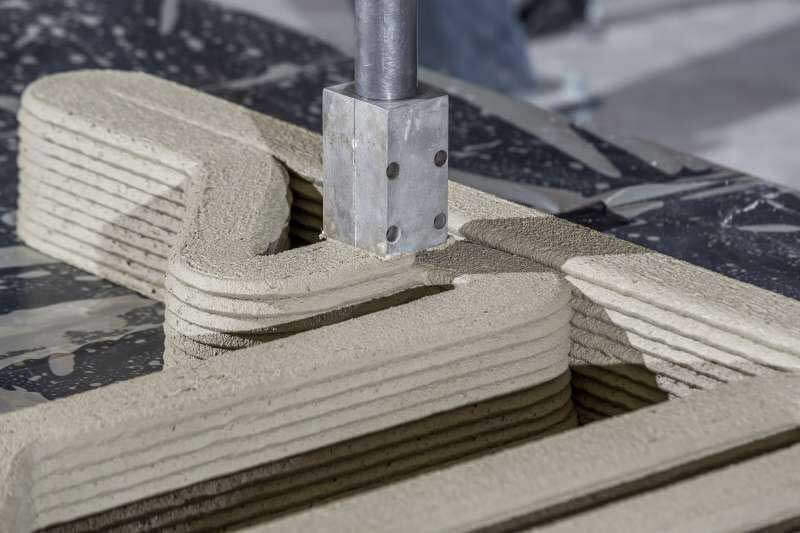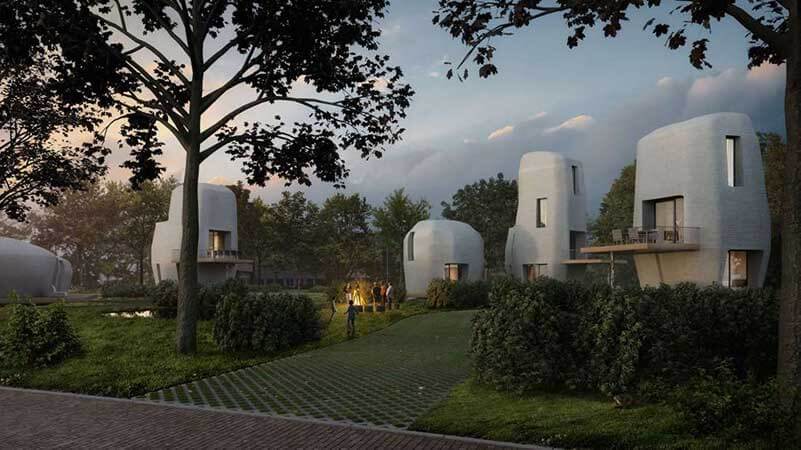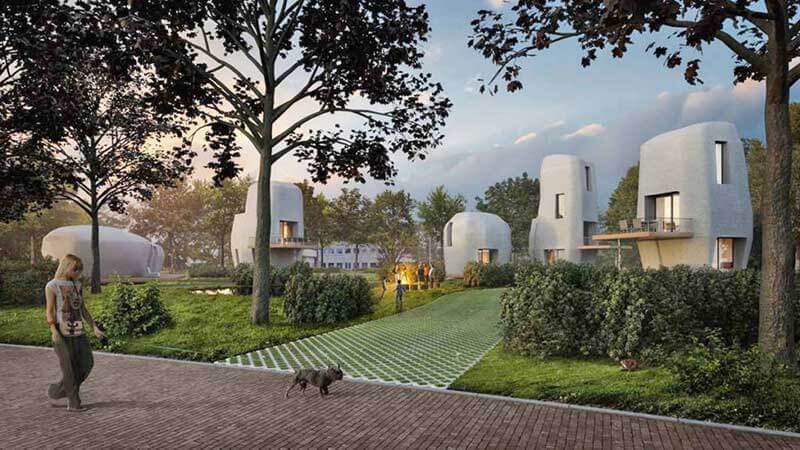- The popularity of 3D printing has increased significantly in recent years
- Eindhoven is about to get the world’s first habitable 3D-printed homes
- Numerous advantages over conventional construction methods
- 3D printing allows you to produce almost any shape
- Painting a promising portrait of the future
The construction industry is considered one of the world’s worst offenders in terms of carbon dioxide emissions. According to a recent study published in the Renewable and Sustainable Energy Reviews journal, the global construction sector was responsible for 5.7 billion tons of CO2 emissions in 2009. That figure accounts for 23 per cent of all CO2 emissions generated across industries. And as the effects of climate change become more and more pronounced, it also becomes increasingly clear that we need to do everything in our power to reduce our environmental impact before it’s too late. As one of the biggest polluters, the construction industry in particular has a lot of room for improvement, and 3D printing could be the way to do it.

The popularity of 3D printing has increased significantly in recent years
3D printing has become incredibly popular in recent years, and it’s had a major impact on many different sectors. Today, it’s used to produce a wide variety of items, from spare parts for various household appliances and cars to clothes and furniture. As the technology matured, it also became possible to create large-scale structures such as bridges, facades, or even entire buildings. Although initially skeptical, construction companies are becoming increasingly aware of the benefits of this emerging technology. Compared to traditional construction methods, 3D printing is cheaper, faster, more environmentally friendly, and produces less waste. But is it really going to revolutionise the construction industry?
The Dutch city of Eindhoven is about to get the world’s first habitable 3D-printed homes
Project Milestone is the name of a new Dutch initiative that aims to build the world’s first habitable 3D-printed homes in the city of Eindhoven. It’s a collaboration between the municipality of Eindhoven, the Eindhoven University of Technology, contractor Van Wijnen, engineering firm Witteveen+Bos, materials company Saint Gobain-Weber Beamix, and real estate manager Vesteda. The project will be realised in the new Meerhoven district, located west of the city, near the Eindhoven airport. A total of five concrete houses will be built on the site, with the construction of the first one set to be completed by mid-2019. The houses will be built one at a time to allow the builders to learn from earlier examples and perfect their technique over time. If everything goes according to plan, it will take about five years to complete the entire project.

Numerous advantages over conventional construction methods
According to Rudy van Gurp, a project manager at Van Wijnen, the main goal of the project is to demonstrate how 3D printing technology can help us reduce costs and eliminate concrete waste. “We are reinventing some details in the real estate industry, and it feels to be at a start of a tech revolution in this industry,” says van Gurp. “3D printing makes things quicker, better, cheaper and more sustainable by using less material. It also fosters creativity and freedom in the design,” he adds.
The first home, a single-storey, two-bedroom structure, will be 3D-printed at the Eindhoven University of Technology using its massive concrete printer, and then transported to the site for assembly. It will be printed using a specially formulated concrete mix, which will be deposited one layer at a time. Its walls will be only 5 centimetres thick, as opposed to 10-15 centimetres that you get with conventional construction techniques. “We have no need for the moulds used to create houses made with cement today, and so we will never use more cement than is necessary,” says van Gurp. Since cement production is a major contributor to global CO2 levels, this will help mitigate the problem, pointing to a decided advantage for 3D-printed structures.
The layering technique they used provides several benefits. It makes the walls stronger, improves their acoustic and heat insulation, and allows wireless sensors to be incorporated into the walls during construction to make the house smarter and more efficient. This also helps the environment by reducing the energy consumption of these structures.
3D printing allows you to produce almost any shape
The other houses will be multi-storey, and the plan is to gradually move the manufacturing on-site, with the final house to be printed there in its entirety. So far, the project partners have released renders of what the houses will look like once they’re finished, and these have attracted a lot of interest. The houses are rather unusual and have been described as “erratic blocks in a green landscape”. This illustrates another advantage of 3D printing – it allows you to experiment with shapes that can’t be achieved with conventional construction techniques.
The houses won’t be available for purchase, though. Instead, they’ll be rented out by the real estate company Vesteda, one of the partners on the project, once they go through mandatory safety tests. There certainly won’t be a shortage of interested parties, as more than 20 families have already submitted their applications to live in the first one.
The ultimate goal, claims van Gurp, is to enable people to use 3D printing to tailor their future homes according to their tastes. “We like the look of the houses at the moment as this is an innovation and it is a very futuristic design,” he says. “But we are already looking to a take a step further and people will be able to design their own homes and then print them out. People will be able to make their homes suit them, personalise them, and make them more aesthetically pleasing”.

However, 3D printing does have certain disadvantages. First, there’s the matter of the initial cost of the technology, as a high-end printer can cost a couple of million dollars. 3D printers are also limited when it comes to the size of the building they can produce, so they can’t be used to print something like a mall or a skyscraper yet. Then, there’s the issue of building codes and regulations, which haven’t been updated to make provisions for the new technology. Finally, there are also those who question the safety and durability of 3D-printed buildings.
Painting a promising portrait of the future
3D printing has the potential to revolutionise the construction industry. It’s cheaper, faster, more environmentally friendly, and produces less waste than conventional construction methods. It also provides more freedom in terms of design, allowing you to create unusual shapes that can’t be achieved with conventional techniques. And even though there are barriers to the widespread adoption of this tech in construction, current projects paint a promising portrait of the future.




